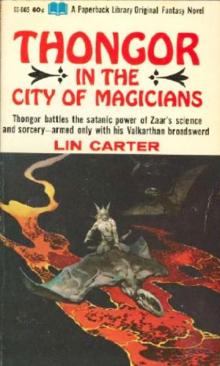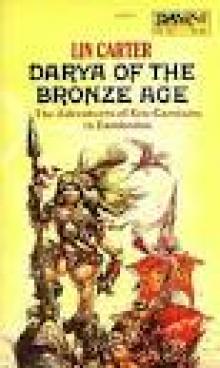- Home
- Lin Carter
Lin Carter - The Man Who Loved Mars Page 4
Lin Carter - The Man Who Loved Mars Read online
Page 4
It seemed that only the Doctor and I had ever been on Mars before. So we helped the other two accustom themselves to the use of their respirators. Of the four of us, only I had ever undergone the Mishubi-Yakamoto treatments and could do without the artificial breathing boosters.
We had come down just where the Doc had planned. All about us, but tapering off due west, the canal extended like a four-foot-high miniature jungle. Seen from above��� it was to be hoped!���the Antoine d’Eauville ought to blend unobtrusively with the shrubbery. Of course, to anyone crossing Phaethontis either afoot, on slidar, or by sand-tractor, it would stand out somewhat more prominently than a dozen sore thumbs, and that we could not help. However, this was the edge of the Drylands, and nobody ever comes this far south, not even the People, for the very good reason that there is nothing here to attract them.
Actors on the cube, stuck in a space-adventure epic, always make planetfall, crack the seal, and hit dirtside in no time flat. The conventions of stereovision drama aside, in real life it takes from two to three hours before you are ready to leave the spacecraft. You have to deprogram your computer, dampen the power pile, let the fabric cool, run triple checks for a burst seam, check out suits and respirators, and do a hundred other things. In our case, as we would not be coming back to the craft until this whole expedition was over, it took closer to five hours before we were ready to depart.
It was Bolgov’s task to unlimber the gig. He sprung the cargo port and lifted the gig out of its cradle next to the Lanzetti, using the cargo crane, and set it down gently in the dark mossy foliage.
The craft’s gig, in this case, was an atmospheric skimmer instead of the usual two-man space boat. Actually, they had chosen well in picking a skimmer, since it is the fastest and most practical mode of transport that can be used on Mars, certainly dozens of times faster and more comfortable than a sand-tractor. Bolgov and Keresny then began to stow our gear aboard the skimmer. I suppose I should have gone to lend them a hand, but I could not do it, somehow. I wanted to savor to the fullest my first moment on Mars after all these lonely, empty, bitter years.
So I came out of the airlock below the control blister, climbed down the extensible ladder, jumped down to the springy moss, and then just stood there for a long moment, tasting the dry, spicy tang of the cold, thin air of Mars, feeling the crispness of the rubbery-tendriled moss underfoot, and the exhilarating lightness of Martian gravity. How long, how long since I had tested that ozonous tang at the back of my mouth, how long since I had felt the skin of my face pucker and roughen to the biting chill in the air … ?
I stood there silent and motionless for a long time, brooding on old, glorious dreams and the memory of comrades I had known and loved, all dead men now, with six feet of dry Martian dust their everlasting home. My eyes filled and ran over with tears. Tears that vanished and were gone almost in the same instant they were shed. Tears that the desiccated Martian air drank thirstily, grateful for the rare gift of moisture …
I looked about me, eyes blurring, remembering…
My memory drifted back to my first landing on Mars, years and years ago. When I was young and raw and green and idealistic. I recalled how we had ridden down in a little, crowded, rattletrap satellite shuttle from Deimos Terminal, flying east across the Tharsis region to make planetfall at the debarkation camp out in Isidis Regio. I remembered how 1 had felt then when I first came out of the lock with the other new arrivals, breathing hoarsely through the strange, ill-fitting respirators, waiting to pile on the long tractor train for an interminable, bumpy ride across the craterlets to Syrtis. Staring about me then, I had been struck dumb with awe at the utter strangeness of the scene���the dim, flat stretch of the Isidis dustlands; the grim, dark, shaggy bulk of Syrtis Major, thrusting like a wedge-shaped peninsula deep into the sea of fantastic yellow sands; and the glistening pile that was Syrtis Colony itself, rising on the oddly near horizon, a haze of dim foggy blue from the earth-density air trapped within its hemispherical MPB field.
As we had approached the colony itself, several of my fellow travelers were loudly exclaiming that they had thought the city was supposed to be domed. Did Colonial Administration expect them to wear these uncomfortable masks all the time?
I remember the offhand manner in which the tractor jockey, an old Mars hand, lean as a rail and mahogany brown from deep space radiation, explained laconically that the original colony had been set up under a collapsible plastic dome���“too damned easily collapsible,” was his joke. But that was back before they invented the molecular-potential barrier field, an energy plane whose surface-tension charge repelled air molecules and stabilized internal air pressure, which made it possible to build up and maintain an atmospheric pressure of Earth-norm density���
“Oh!”
The mood snapped at the unexpected sound. I turned. The girl, Ilsa, had followed me out of the lock and was taking her first look at the surface of Mars. I went over and stood beside her; her eyes were wide with amazement, and she sucked in her breath in a gasp and sank her fingers in my arm. I didn’t blame her: your first actual look at the Martian landscape can be an amazing experience.
The craters are the first surprise Mars has for you. There are so many of them, and they are everywhere. Some of them are just little pockmarks in the ground that you can barely put your fist into; and they range all the way up to the super-monster, in the southeastern corner of whose ringwall the entire colony of Sun Lake City is built.
Her fingers dug in. I glanced down, seeing her wide-eyed stare beneath the goggles, and grinned faintly, remembering my own astonishment. For the second big surprise is when you discover that the Red Planet is not red at all, but a patchwork crazy-quilt of yellow dustlands and blue moss growth, broken here and there by vivid patches of raw orange and brilliant, impossible purple.
The first settlers couldn’t get over their amazement at the color scheme. Which is absurd, but human enough. In hindsight it’s hard to understand how anybody ever made the mistake of thinking Mars was going to be red. After all, one of the Russian scientists, Tikhov or somebody like that, deduced that Martian vegetation, if there turned out to actually be any Martian vegetation, would have to be blue in order for the planet to look red from the viewpoint of Earthside visual astronomers. He realized that more than a century and a half ago, back around 1909. And it wasn’t even that clever a deduction in the first place. All it took was a fair grasp of the mechanics of light, which the old-time boys had figured out even earlier, starting with Newton.
We just stood there for a while, just staring around. The sky was dead, dull black, lightening a little toward dusty violet at the edges of the horizon where the air molecules got a chance to bunch up a bit and do some diffracting. The stars were piercingly sharp and clear, and they were weirdly different from the stars you see at night, Earthside. These did not twinkle, did not waver in the slightest, and they were the damndest colors. Earthside the stars mostly seem glittering, flashing white, sometimes with a touch of blue or red, but that is simply because the faint colors of starlight have little chance of getting through Earth’s mulligan stew of an atmosphere. Here they blaze in the rarest of colors: half a dozen shades of green and blue, all tones from pale yellow through red, and even a few you simply wouldn’t believe, like Alpha Derceto, which is pure brown, and Delta Erigius, which is puce.
She was looking up, searching about-. Grinning, I asked her if she was looking for the moons, and she nodded and asked where they were. I tried to tell her that they were simply too damn small to be visible to the unaided vision, except under certain rather rare circumstances, but she found that impossible to believe.
“But that’s simply insane!” she said, the thin air making her voice tinny and flat. “Why, back home you can even see a communications satellite on clear nights, if you know where to look. And they’re only ten or fifteen feet across, where here��� Well, Deimos, the nearest moon, is supposed to have a diameter of ten miles. I
t’s just crazy to say you simply can’t see them at all!”
“I didn’t say you couldn’t see them at all, I said they were too small to be seen except under certain rare conditions,” I reminded her. “One of those conditions is knowing just where to look. In the first place, Deimos is the outer moon, not the nearest, and it’s the only one you can see without magnification, because it moves so very slowly ���it takes two days, local time, to cross the sky. The trouble is that it has a lousy albedo, and it’s too high for its size to make any difference in its degree of visibility.”
She sounded dubious. “Is that really true? What about the other one?”
“Phobos you never can see at all,” I told her, “even though it’s bigger than Deimos, has a higher albedo���that means ‘reflecting power,’ by the way. It’s also very, very, very close to the surface of the planet.”
“Then why can’t you see it?”
“Because it moves too fast. It goes all around the planet three whole times in a single day, and if you don’t think that is fast, well, stop and think about it.”
The Man Who Loved Mars 43 “But I still don’t see���!”
“You simply can’t know where precisely to look for it. It’s a question of albedo, for the most part. You see, Mars is so much farther from the sun than Earth is that we don’t get more than a tiny fraction of the light Earth gets. Now back on Earth, a full moon is dazzlingly bright, because it has an awful lot of light to reflect. But here the moons have only a tiny fraction of that much light, and they have lower albedos too.
“But the main problem with Phobos is not that it is much too dim and dark to show up very well, but it whizzes by so rapidly that you never know just where in the sky to look for it at any given time. You have to search the sky from horizon to horizon, slowly and carefully, and even then, under the best of conditions you’d have to be mighty lucky to���”
I broke off as moss rustled and squeaked under heavy boots behind me.
“Your first lesson in Marsology, my dear?” Dr. Keresny broke in amiably. “Forgive me for interrupting, but the skimmer is all packed. Cn. Tengren, we are ready when you are.”
4. Beyond Death River
The skimmer was cramped, crowded, and hot. Leastways, it seemed hot to me, for my surgically implanted energy centers were already beginning to adjust to the freezing temperatures. My companions,’ on the other hand, were shivering even in their thermal suits and were happy to warm up; happy, also, to remove their bulky respirators for a while.
Our arrival time had been calculated to a nicety. The sun���which looked shockingly pale and shrunken and cool from here���was at its zenith. That gave us several hours of flying time till nightfall. Once darkness came down, of course, it would be impossible to keep on flying, and we would have to camp for the night. But by then we would be deep in the Drylands, with lots of real estate behind us and our journey well begun.
With Bolgov handling the controls, we flew due west. The shaggy border of the canal shrank behind us, merging in a purplish-brown line that seemed to stretch across the world from north to south with such perfect precision that you could swear it had been inked across the dustlands with a mapping pen. The canals of Mars are really patchy, broken areas of low, thick-leafed shrubs and very dense moss which flourish���if that’s really the word for such marginal survival���along subsurface crustal lesions where moisture has been trapped for ages by sheets of solid bedrock. From a distance, due to optical effects, these fertile stretches of vegetation seem to take on an astoundingly regularity which suggested to early astronomers that they were vast artificial waterways, like those our own ancestors built at Suez and Panama. The optical illusion is a simple one, really: look at any photograph in a newsfax. Seen way up close, the picture breaks down into a pattern of square dots, but held at arm’s length the dots merge and blur into tones between gray and black.
The skimmer droned on across the dustlands of western Phaethontis at the low altitude old Mars hands call dune-hopping. Bolgov might be surly and heavy handed, but he knew his trade. There’s quite a trick to keeping a skimmer aloft, even with all the help of the enormous, paper-thin extensible foils.
Ahead of us, and a trifle to the north, the hilly edges of the Cimmerium drifted closer. A dark, dull, fairly even, plateaulike mass of brownish-purple, slashed by the unbroken ink black of the great ravines which cleft it asunder in a thousand places. An area like the Mare Cimmerium is an amusing contradiction in terms. Early astronomers, noting the large, dark-colored areas that mottled the surface of Mars, thought they were seas and named them thus in Latin. The element of contradiction comes in later. That is, when the first expeditions got here, they discovered the larger, lighter-colored areas, the dustlands, were what had been left behind when the real seas evaporated millions of years ago, and the dark patches were actually former continents, cracked apart by gullies the size of the Grand Canyon by the shrinking of the crust.
1 began idly questioning Keresny as to the site of the so-called Treasure City. The ancient thought record he had found up at Thoth-Nepenthes had given the site with particular detail. Scholars have spent twenty years striving to figure out the peculiar geographical notation employed by the Ancients and have come up with a rough but workable system. The location revealed in the thought record worked out to south latitude 27’ 11��, east longitude 140’ 37��. That would place the city very deep in the Mare Cimmerium, about equidistant between the two dustlands of Hesperia and Eridania. And that meant we had a lot of scenery to cover before we could even get close to the goal of our quest.
“Well, the best way to do it is to circle south of the Cimmerium, keeping well out in the dustlands,” I advised. “Flying over the Cimmerium plateau itself is very tricky business, and skimmers don’t handle very easily at any kind of altitude.”
“That’s going to take forever,” Bolgov growled over his shoulder. “We’re too far south as it is, right now.”
“It’s going to be quite a trip,” I admitted. “But an old plateau like the Cimmerium is dangerous. Riddled with fumaroles that create sharp updrafts that could shatter your foils, knock you out of the air. Down below most of the Maria are pockets of natural gas that leak steadily into the atmosphere under terrific pressure. You don’t have to cope with anything like that over the lower dustlands.”
“What happens, then, when ‘we arrive at our longitude?” the Doctor asked. “How can we go north into Mare Cimmerium, unless we use the skimmer?”
I shrugged. “We’ll have to leave the skimmer as close to the foot of the plateau as we can get and go ahead on foot. With any kind of luck we might be able to find a hefty ravine that cuts deeply into the plateau on the north-south line. Some of them are as big as the Grand Canyon of Wyoming; some are even bigger.”
“Do you suppose we could fly up the ravine?” Usa asked. “If they’re that big … I mean, the Grand Canyon is several miles wide at some points, isn’t it? Surely, despite our wingspread, we could navigate without fouling them.”
I shook my head. “No, you see, it isn’t a matter of fouling the wings���the foils, I mean���some of the chasms are twenty miles wide from cliff wall to cliff wall. But the bottom of the ravines are pimpled with fumaroles, and the gas escapes in narrow jets under tremendous pressure. The ravines are more dangerous to a skimmer than the plateau itself, for that reason. No, we’ll just have to go it on foot. Unless we happen to run into some of the People and can get slidars from them. But that’s unlikely, way down here near the South Pole cap.”
Brother Konstantin grumbled a bit and swore about dragging out the time factor, but the Doctor put his foot down, saying that here I was the expert and that my advice was sound and we would follow it. After that the conversation lapsed lamely into silence. I leaned back against the luggage net and dozed off.
We flew on until sundown. The atmosphere of Mars is too thin to make for gorgeous sunsets-���-too thin too for ligh
t to linger in long twilights. On Mars, darkness falls suddenly with sunset, all at once: like a great black curtain drawn swiftly across the heavens.
Bolgov brought the skimmer down to a long, easy, gliding stop, talcum-fine sand dust hissing under the runners. By the glow of a Bronston lamp we set up the vacuum-tight thermal tents, while Ilsa prepared food. It was very hard to set a fire in this oxygen-starved atmosphere, but Keresny was an old Mars hand and knew that already. So the provisions included some self-heating containers the Mandate cops use during field problems: you twist the top to break the seal, wait five minutes, then spoon out the hot stew or soup or whatever. I wanted to eat out under the stars, but as my companions would find it rather hard to eat dinner through a respirator, we ate in the larger tent that the Doctor would share with his granddaughter. Keresny had brought along a canister of champagne, and we drank a toast to the success of our search, but the change in atmospheric pressure made the champagne flat, and it tasted stale.
That night I dreamed of Yakla, the little silver beads glittering like stars in the night-black curtain of her hair. It was not a happy dream, and I woke before dawn as weary as if I had not slept at all.
We flew on all that day and all of the next crossing the broad isthmus of the Simois into the upper tip of Electris. By the next day we had flown across the Scamander canal and were in the dustlands of Eridania. It took us a whole day of steady travel to cross the broad bowl of yellow dust, and we were all restless and quarrelsome from being cooped up for so many endless hours in the narrow confines of the skimmer’s cabin. Bolgov was grumbling over the fact that we could have set the d’Eauville down in the Scamander instead of the Thermodon and saved ourselves two days of flying. Keresny, with his saintly patience wearing a bit thin, told once again of the dangers of trying for a planetfall so hazardously near to Laestrygonum colony, which was on the Sinus just north of the Cimmerium.

 Zanthodon
Zanthodon Thongor in the City of Magicians
Thongor in the City of Magicians Thongor at the End of Time
Thongor at the End of Time The Valley Where Time Stood Still
The Valley Where Time Stood Still Journey To The Underground World
Journey To The Underground World Darya of The Bronze Age
Darya of The Bronze Age Eric of Zanthodon
Eric of Zanthodon Hurok Of The Stone Age
Hurok Of The Stone Age Tower Of The Medusa
Tower Of The Medusa Thongor Fights the Pirates of Tarakus
Thongor Fights the Pirates of Tarakus The Zanthodon MEGAPACK ™: The Complete 5-Book Series
The Zanthodon MEGAPACK ™: The Complete 5-Book Series The Quest of Kadji
The Quest of Kadji Lin Carter - The Man Who Loved Mars
Lin Carter - The Man Who Loved Mars Thongor and the Wizard of Lemuria
Thongor and the Wizard of Lemuria The Nemesis of Evil
The Nemesis of Evil H.P.Lovecraft: A Look Behind Cthulhu Mythos
H.P.Lovecraft: A Look Behind Cthulhu Mythos Lin Carter - Down to a Sunless Sea
Lin Carter - Down to a Sunless Sea Horror Wears Blue
Horror Wears Blue Invisible Death
Invisible Death Lin Carter - The City Outside the World
Lin Carter - The City Outside the World The Volcano Ogre
The Volcano Ogre The Man Who Loved Mars
The Man Who Loved Mars